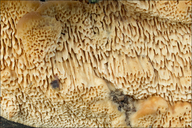|
|
click photo for larger file

Antrodia malicola
|
Photographer: Dr. Amadej Trnkoczy
ID: 0000 0000 0313 2848 (2013-03-17)Copyright © 2013 Dr. Amadej Trnkoczy
|
|
INFORMATION PROVIDED WITH THE PHOTO
|
date of photo Jan 9, 2013
latitude 46.32658 longitude 13.52205
View on Google Maps.
location
Bovec basin, south of Bovec golf play ground, East Julian Alps (Posočje, Slovenia)notes UPDATED INFORMATION: Antrodia malicola, syn. Coriolellus malicola (Berk. & M.A. Curtis) Murrill (1920), Daedalea malicola (Berk. & M.A. Curtis) Aoshima (1967), Trametes jamaicensis Murrill (1910), Trametes malicola Berk. & M.A. Curtis (1856) Slo.: rjavkasta trhlica Date: Jan. 30. 2014 A piece of herbarium specimen has been sent to Mr. Günter Sturm, Germany for evaluation. He has a very long 'mileage' with Polyporaceae. His habit and microscopic examination yields Antrodia malicola. This is a rather rare polypore (found in three MTB sub-squares in Slovenia) with clamped septs of the hypha and dimitic hypha system. He also found and examined a few spores. All characteristics meet the expectations for this species. He also mentions that, although Antrodia doesn’t belong to the Hymenochaetaceae, A. malicola is an exception and reacts with KOH by blackening as it is demonstrated also on one of the pictures attached to the observation Antrodia malicola - I. In the Rhine-Main-Area of Germany, where he lives, they have about 20 finds of A. malicola up to now and he knows the taxon well. The main substrate is Fagus, but it was found also on Carpinus. The mushroom has a fine-aromatic smell, which I somehow overlooked. Günter thank you for your interest and time. _______________________________ Former text: Slo.: �afranasti (?) zlatoluknjičar - Coriolopsis trogii (Berk.) Dom., syn: Trametes trogii Berk or Hapalopilus croceus ? (Pers.) Donk, syn.: Aurantiporus croceus, Inonotus croceus, Phaeolus croceus, Tyromyces croceus - Habitat: Former pasture, on top of a pile of firewood; flat terrain, calcareous ground, full sun, exposed to direct rain, average precipitations ~ 3.000 mm/year, average temperature 8-10 deg C, elevation 400 m (1.300 feet), alpine phytogeographical region. - Substratum: a cut down, dead, rotten but partly still in bark trunk of Ostrya carpinifolia (about 15 cm diameter) used as a weight and laying on a pile of firewood. - Comments: I�ve browsed through a lot of literature without a really convincing determination of this observation. Basidiocarps� habitus corresponds well to Hapalopilus crocerus, however measured spores do not fit. A potential candidate could also be a kind of Coriolopsis. Spores of C. gallica fit well to the measured ones, but color of basidiocarps doesn�t at all. Color of the observation could eventually fit to C. trogii (Berk.) Dom. (syn: Trametes trogii) (considering young basidiocarps), but it has somewhat narrower spores and its substrate is usually Populus. sp. Ostrya carpinifolia is not cited as possible substrate in Ref.:(3). I was unable to find another so distinctly yellow-orange-ochre Polyporaceae with such spores. - Growing in a small group of about 5 basidiocarps, all effused-reflexed, up to about 10 cm wide, pilei up to 1 cm broad, pores 1-3 per mm, irregular, angular on horizontal surfaces; basidiocarps moist, rubbery-leathery, fresh, relatively soft; hard and firm when dry, all sporocarps were apparently young or very young; smell strong, mushroomy; trama brown-red (oac707), KOH 5% on flesh and pores very dark carmine red, almost black; SP whitish-beige (oac007), quite abundant for Polyporaceae. - Spores smooth. Dimensions: 9.7 (SD = 0.8) x 4.1 (SD = 0.3) μ, Q = 2.35 (SD = 0.2), n = 30. Olympus CH20, NEA 100x/1.25, magnification 1.000 x, oil, in water. AmScope MA500 digital camera. - Herbarium: Mycotheca and lichen herbarium (LJU-Li) of Slovenian Forestry Institute, Večna pot 2, Ljubljana - Ref.: (1) Personal communication, provisionally id'ed as Hapalopilus by Mr. Anton Poler. (2) Personal communication, provisionally id�ed as Trametes trogii by Mr. Gregor Podgornik, NAC Tolmin. (3) G.J.Krieglsteiner (Hrsg.), Die Grosspilze Bade-W�rttembergs, Band 1, Ulmer (2000), p 532 and 505. (4) A.Bernicchia, Polyporaceae s.l., Fungi Europaei, Vol. 10., Edizioni Candusso (2005), p 256 and 190. Spores of Hapalopilus croceus 4-6.5/3-4.5 and of Coriolopsis trogii 7-11/2.5-4 (5) J�lich (cited by Ref.:1). Spores of Hapalopilus criceus 3-7/3-4,5camera Nikon D700 / Nikkor Micro 105mm/f2.8
contributor's ID # Bot_685/2013_IMG2269 photo category: Fungi - fungi
|
MORE INFORMATION ABOUT THIS FUNGUS
|
| View all photos in CalPhotos of Antrodia malicola Check Google Images for Antrodia malicola |
|
The photographer's identification Antrodia malicola has not been reviewed. Sign in to review or comment on this photo |
|
Using this photo The thumbnail photo (128x192 pixels) on this page may be freely used for personal or academic purposes without prior permission under the Fair Use provisions of US copyright law as long as the photo is clearly credited with © 2013 Dr. Amadej Trnkoczy.
For other uses, or if you have questions, contact Dr. Amadej Trnkoczy amadej.trnkoczy[AT]siol.net. (Replace the [AT] with the @ symbol before sending an email.) |
|
|
